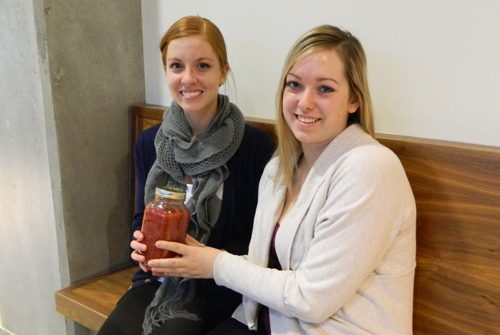
Here’s a math question: How many one-litre jars can you fill when you have 500 pounds of tomatoes to can?
U of G students Andria Baxter and Madison Hurst know the answer because they’ve done it. Their total? “Approximately 200 jars,” says Baxter.
The fourth-year students in hotel and food administration didn’t spend all that time in the kitchen to solve a math question, though. They decided to can the tomatoes as a project for their independent study course taught by Prof. Mike von Massow. “We wanted to show how the otherwise short season for local food can be extended through food preservation,” says Baxter.
Why tomatoes? “We like salsa and tomato sauce,” says Hurst. Their original plan had been to preserve apples as well as tomatoes, but this fall’s local apple crop was so poor that they opted to focus only on tomatoes. Then they ran into another snag: their original source, the Guelph Centre for Urban Organic Tomatoes, didn’t produce enough tomatoes for their purposes.
“In the end, we got our tomatoes from Prof. Simon Day, who was doing purchasing for P.J.’s Restaurant in Elora,” says Hurst.
The canning process also took place in P.J.’s kitchen (a commercial kitchen is required for the processing of any food products that will be sold to the public). “We did the tomatoes in two batches. The first 250 pounds took us about a week – we were running in to work on it between classes, then cleaning everything up so we could go to our next class. It was just the two of us, and it was exhausting,” says Hurst.
They learned their lesson and recruited some help before tackling the remaining tomatoes, says Baxter. “We got the second batch done in one 10-hour day.”
The tomatoes were canned with just a little kosher salt and some citric acid. A little more math shows the benefits of do-it-yourself: the jars of tomatoes cost $1.63 each, including all ingredients plus the cost of the jars themselves. “The jars can be re-used, though, so the cost goes down if you continue after the first year,” says Baxter. “In the grocery store, it would cost between $1.99 and $2.25 for the same amount of canned tomatoes.”
They’re healthier, too: Hurst compared sodium levels in store-bought canned tomatoes (160 mg) to the jars she and Baxter canned (30 mg).
Both of these students are passionate about eating local. “I think one important part is the sense of community that develops when you focus on local foods,” says Baxter. “You get to know the farmers you are buying from and you are supporting them when you buy directly. It also reduces your carbon footprint because the product doesn’t have to travel as far to bring it to market.”
On their blog (lovelocallonger.wordpress.com) they share a couple of the recipes they’ve made using the canned tomatoes. P.J.’s Restaurant has purchased their entire production run and is using the tomatoes for condiments such as tomato jam (Hurst says it’s delicious) and topping for meatloaf. By next spring the blog should also have a calendar of local harvest seasons so readers will know when strawberries are ripe and ready to be picked and when fresh corn-on-the-cob can be expected to show up in farmers’ markets.
“The canning took a long time, but it was fun,” says Baxter, who has already bought a pressure canner so she can continue preserving food at home. “It’s neat as well to see the things you can make out of the tomatoes. Canning is kind of addictive.”
Both say the experience has changed their perspective on the food industry and their future careers in hotel and food administration. “I’m more passionate about local foods now,” says Baxter. Hurst adds, “It’s helped me see how the industry can contribute to sustainability by make some simple choices.”